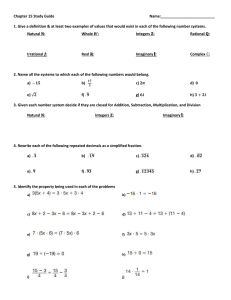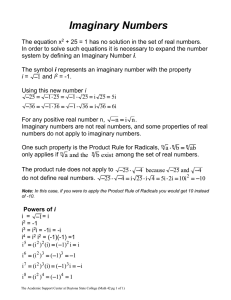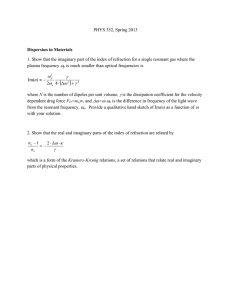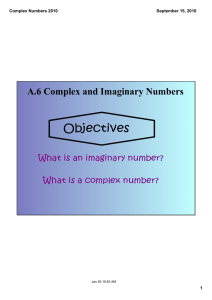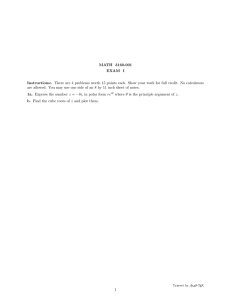Electric Charge as a Form of Imaginary Energy
advertisement
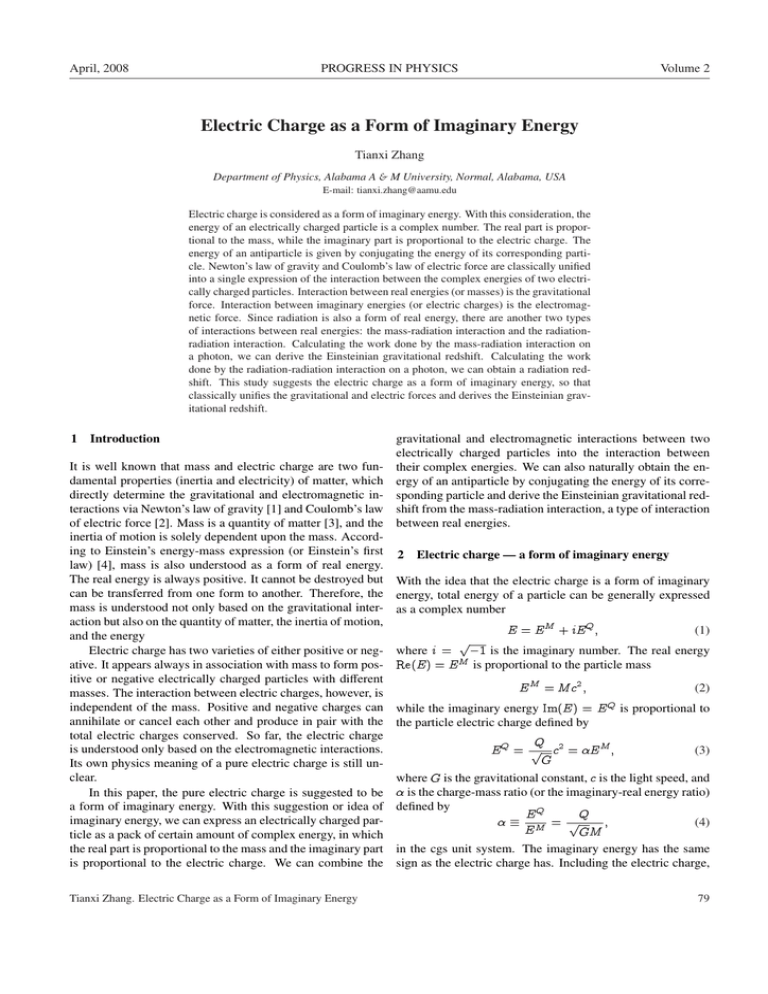
April, 2008 PROGRESS IN PHYSICS Volume 2 Electric Charge as a Form of Imaginary Energy Tianxi Zhang Department of Physics, Alabama A & M University, Normal, Alabama, USA E-mail: tianxi.zhang@aamu.edu Electric charge is considered as a form of imaginary energy. With this consideration, the energy of an electrically charged particle is a complex number. The real part is proportional to the mass, while the imaginary part is proportional to the electric charge. The energy of an antiparticle is given by conjugating the energy of its corresponding particle. Newton’s law of gravity and Coulomb’s law of electric force are classically unified into a single expression of the interaction between the complex energies of two electrically charged particles. Interaction between real energies (or masses) is the gravitational force. Interaction between imaginary energies (or electric charges) is the electromagnetic force. Since radiation is also a form of real energy, there are another two types of interactions between real energies: the mass-radiation interaction and the radiationradiation interaction. Calculating the work done by the mass-radiation interaction on a photon, we can derive the Einsteinian gravitational redshift. Calculating the work done by the radiation-radiation interaction on a photon, we can obtain a radiation redshift. This study suggests the electric charge as a form of imaginary energy, so that classically unifies the gravitational and electric forces and derives the Einsteinian gravitational redshift. 1 Introduction gravitational and electromagnetic interactions between two electrically charged particles into the interaction between It is well known that mass and electric charge are two fun- their complex energies. We can also naturally obtain the endamental properties (inertia and electricity) of matter, which ergy of an antiparticle by conjugating the energy of its corredirectly determine the gravitational and electromagnetic in- sponding particle and derive the Einsteinian gravitational redteractions via Newton’s law of gravity [1] and Coulomb’s law shift from the mass-radiation interaction, a type of interaction of electric force [2]. Mass is a quantity of matter [3], and the between real energies. inertia of motion is solely dependent upon the mass. According to Einstein’s energy-mass expression (or Einstein’s first 2 Electric charge — a form of imaginary energy law) [4], mass is also understood as a form of real energy. The real energy is always positive. It cannot be destroyed but With the idea that the electric charge is a form of imaginary can be transferred from one form to another. Therefore, the energy, total energy of a particle can be generally expressed mass is understood not only based on the gravitational inter- as a complex number action but also on the quantity of matter, the inertia of motion, E = E M + iE Q ; (1) and the energy p Electric charge has two varieties of either positive or neg- where i = 1 is the imaginary number. The real energy ative. It appears always in association with mass to form pos- Re(E ) = E M is proportional to the particle mass itive or negative electrically charged particles with different E M = Mc2 ; (2) masses. The interaction between electric charges, however, is independent of the mass. Positive and negative charges can while the imaginary energy Im(E ) = E Q is proportional to annihilate or cancel each other and produce in pair with the the particle electric charge defined by total electric charges conserved. So far, the electric charge Q is understood only based on the electromagnetic interactions. E Q = p c2 = E M ; (3) G Its own physics meaning of a pure electric charge is still unclear. where G is the gravitational constant, c is the light speed, and In this paper, the pure electric charge is suggested to be is the charge-mass ratio (or the imaginary-real energy ratio) a form of imaginary energy. With this suggestion or idea of defined by Q EQ imaginary energy, we can express an electrically charged par M = p ; (4) E GM ticle as a pack of certain amount of complex energy, in which the real part is proportional to the mass and the imaginary part in the cgs unit system. The imaginary energy has the same is proportional to the electric charge. We can combine the sign as the electric charge has. Including the electric charge, Tianxi Zhang. Electric Charge as a Form of Imaginary Energy 79 Volume 2 PROGRESS IN PHYSICS April, 2008 we can modify Einstein’s first law as E = (1 + i)Mc2 : (5) The modulus of the complex energy is jE j = p 1 + 2 Mc2 : (6) For an electrically charged particle, the absolute value of is a big number. For instance, proton’s is about 1018 and electron’s is about 2 1021 . Therefore, an electrically charged particle holds a large amount of imaginary energy in comparison with its real or rest energy. A neutral particle such as a neutron, photon, or neutrino has only a real energy. 3 Unification of Newton’s law of gravity and Coulomb’s law Fig. 1: Interactions between two electrically charged particles. They iclude (1) the gravitational force between masses, (2) the electric force between charges, and (3) the imaginary force between mass and charge. Considering two pointlike electrically charged objects with masses M1 , M2 , electric charges Q1 , Q2 , and distance r, we can unify Newton’s law of gravity and Coulomb’s law of electric force by the following single expression of the interaction between complex energies F~ = EE G 41 32 ~r; cr (7) where E1 is the energy of object one and E2 is the energy of object two. Eq. (7) shows that the interaction between two particles is proportional to the product of their energies and inversely proportional to the square of the distance between them. Replacing E1 and E2 by using the complex energy ex- Fig. 2: Interactions between two electric charges. They include (1) repelling between two positive charges, (2) repelling between two pression (1), we obtain MM QQ F~ = G 1 3 2 ~r + 1 3 2 ~r r r ~ ~ ~ = FMM + FQQ + iFMQ : p M Q +M Q i G 1 2 3 2 1 ~r = r (8) The first term of Eq. (8) represents Newton’s law for the gravitational interaction between two masses F~MM . The second term represents Coulomb’s law for the electromagnetic interaction between two electric charges F~QQ . The third term is an imaginary force between the mass of one object and the electric charge of the other object iF~MQ . This imaginary force is interesting and may play an essential role in adhering an electric charge on a mass or in combining an imaginary energy with a real energy. A negative imaginary force adheres a positive electric charge on a mass, while a positive imaginary force adheres a negative electric charge on a mass. Figure 1 sketches all of the interactions between two electrically charged particles as included in Eq. (8). Electric charges have two varieties and thus three types of interactions: (1) repelling between positive electric charges F~++ , (2) repelling between negative electric charges F~ , and (3) attracting between positive and negative electric charges F~+ . Figure 2 shows the three types of the Coulomb interactions between two electric charges. 80 negative charges, and (3) attraction between positive and negative charges. 4 Energy of antiparticles The energy of an antiparticle [5, 6] is naturally obtained by conjugating the energy of the corresponding particle E = E M + iE Q = EM iE Q : (9) The only difference between a particle and its corresponding antiparticle is that their imaginary energies (thus their electric charges) have opposite signs. A particle and its antiparticle have the same real energy but have the sign-opposite imaginary energy. In a particle-antiparticle annihilation process, their real energies completely transfer into radiation photon energies and their imaginary energies annihilate or cancel each other. Since there are no masses to adhere, the electric charges come together due to the electric attraction and cancel each other (or form a positive-negative electric charge pair (+, )). In a particle-antiparticle pair production process, the radiation photon energies transfer to rest energies with a pair of imaginary energies, which combine with the rest energies to form a particle and an antiparticle. Tianxi Zhang. Electric Charge as a Form of Imaginary Energy April, 2008 PROGRESS IN PHYSICS Volume 2 To describe the energies of all particles and antiparticles, we can introduce a two-dimensional energy space. It is a complex space with two axes denoted by the real energy Re(E ) and the imaginary energy Im(E ). There are two phases in the energy space. In phase I, both real and imaginary energies are positive, while, in phase II, the imaginary energy is negative. Neutral particles including massless radiation photons are located on the real energy axis. Electrically charged particles are distributed between the real and imaginary energy axes. A particle and its antiparticle cannot be located in the same phase of the energy space. 5 Quantization of imaginary energy Fig. 3: Three types of gravitational interactions between real energies: (1) the mass-mass interaction, (2) the mass-radiation interaction, and (3) the radiation-radiation interaction. The imaginary energy is quantized. Each electric charge quantum e (the electric charge of proton) has the following imaginary energy large amount of imaginary energy (or electric charge) to real e 2 15 27 e E = p c 1.67 10 ergs 10 eV; (10) energy. G which is about 1018 times greater than proton’s real energy (or the energy of proton’s mass). Dividing the size of proton (10 15 cm) by proton’s imaginary-real energy ratio (1018 ), we obtain a scale length lQ = 1033 cm. On the other hand, Kaluza-Klein theory geometrically unified the four-dimensional Einsteinian general theory of relativity and Maxwellian electromagnetic theory into a fivedimensional unification theory ([7–9] for the original studies, [10] for an extensive review, and [11, 12] for the field solutions). In this unification theory, the fifth dimension is a compact (one-dimensional circle) space with radius 1033 cm [13], which is about the order of lQ obtained above. The reason why the fifth dimensional space is small and compact might be due to that the imaginary energy of an electrically charged particle is many orders of magnitude higher than its real energy. The charge is from the extra (or fifth) dimension [14], a small compact space. A pure electric charge is not measureable and is thus reasonably represented by an imaginary energy. The imaginary energy of the electric charge quantum is about the thermal energy of the particle at a temperature TQ = = 2E e =kB 2.4 1031 K. At this extremely high temperature, an electrically charged particle (e.g. proton) has a real energy in the same order of its imaginary energy. According to the standard big bang cosmology, the temperature at the grand unification era and earlier can be higher than about TQ [15]. To have a possible explanation for the origin of the universe (or the origin of all the matter and energy), we suggest that a large electric charge such as 1046 Coulombs (1076 ergs) was burned out, so that a huge amount of imaginary energies transferred into real energies at the temperature TQ and above during the big bang of the universe. This suggestion gives a possible explanation for the origin of the universe from nothing to the real world in a process of transferring a Tianxi Zhang. Electric Charge as a Form of Imaginary Energy 6 Gravitational and radiation redshifts Real energies actually have two components: matter with mass and matter without mass (i.e. radiation). The interactions between real energies may be referred as the gravitation in general. In this sense, we have three types of gravitations: (1) mass-mass interaction F~MM , (2) mass-radiation interaction F~M , and (3) radiation-radiation interaction F~ . Figure 3 sketches all these interactions between real energies. The energy of a radiation photon is given by h , where h is the Planck’s constant and is the frequency of the radiation. According to Eq. (7), the mass-radiation interaction between a mass M and a photon is given by F~ = Mh G 2 3 ~r ; cr (11) and the radiation-radiation interaction between two photons 1 and 2 is given by F~ = G (h1 )(h2 ) ~r : c4 r3 (12) Newton’s law of gravity describes the gravitational force between two masses F~MM . The Einsteinian general theory of relativity has successfully described the effect of matter (or mass) on the space-time and thus the interaction of matter on both matter and radiation (or photon). If we appropriately introduce a radiation energy-momentum tensor into the Einstein field equation, the Einsteinian general theory of relativity can also describe the effect of radiation on the space-time and thus the interaction of radiation on both matter and radiation. When a photon of light travels relative to an object (e.g. the Sun) from ~r to ~r + d~r, it changes its energy or frequency from to + d . The work done on the photon by the massradiation interaction (F~M d~r) is equal to the photon energy 81 Volume 2 change (hd ), i.e., PROGRESS IN PHYSICS April, 2008 action between complex energies. Details of the study including the color charge will be given in the next paper. (13) Eq. (1) does not include the self-energy — the contribution to the energy of a particle that arises from the interaction Eq. (13) can be rewritten as between different parts of the particle. In the nuclear physics, d GM = 2 2 dr : (14) the self-energy of a particle has an imaginary part [19, 20]. cr The mass-mass, mass-charge, and charge-charge interactions Integrating Eq. (14) with respect to r from R to 1 and between different parts of an electrically charged particle will from e to o , we have be studied in future. GM o As a summary, a pure electric charge (not observable and ; ln = (15) from the extra dimension) has been suggested as a form of e c2 R where R is the radius of the object, e is the frequency of the imaginary energy. Total energy of an electrically charged parlight when it is emitted from the surface of the object, o is ticle is a complex number. The real part is proportional to the the frequency of the light when it is observed by the observer mass, while the imaginary part is proportional to the electric at an infinite distance from the object. Then, the redshift of charge. The energy of an antiparticle is obtained by conjugating the energy of its corresponding particle. The gravitational the light is and electromagnetic interactions have been classically unified e e o GM ZG = o 1 : (16) into a single expression of the interaction between complex = = exp 2 e o cR energies. The interactions between real energies are gravitational In the weak field approximation, it reduces forces, categorized by the mass-mass, mass-radiation, and GM ZG ' 2 : (17) radiation-radiation interactions. The work done by the masscR radiation interaction on a photon derives the Einsteinian Therefore, calculating the work done by the massgravitational redshift, and the work done by the radiationradiation interaction on a photon, we can derive the Einsteinradiation interaction on a photon gives the radiation redshift, ian gravitational redshift in the weak field approximation. which is significantly small in comparison with the gravitaSimilarly, calculating the work done on a photon from an tional redshift. object by the radiation-radiation gravitation F~ , we obtain a The interaction between imaginary energies is electroradiation redshift, magnetic force. Since an electrically charged particle con4 GM G Z = (18) tains many order more imaginary energy than real energy, ATc4 + 5 ATs4 ; 5 15c c the interaction between imaginary energies are much stronger where is the Stephan-Boltzmann constant, A is the surface than that between real energies. area, Tc is the temperature at the center, Ts is the temperature Overall, this study develops a new physics concept for on the surface. Here we have assumed that the inside temper- electric charges, so that classically unifies the gravitational ature linearly decreases from the center to the surface. The and electric forces and derives the Einsteinian gravitational radiation redshift contains two parts. The first term is con- redshift. tributed by the inside radiation. The other is contributed by the outside radiation. The redshift contributed by the outside Acknowledgement radiation is negligible because Ts Tc . The radiation redshift derived here is significantly small This work was supported by NASA NNG04GD59G A/C in comparison with the empirical expression of radiation red- 2-302-14-3380-119. shift proposed by Finlay-Freundlich [16]. For the Sun with Submitted on January 28, 2008 Tc = 1.5 107 K and Ts = 6 103 K, the radiation redshift Accepted on February 01, 2008 is only about Z = 1.3 10 13 , which is much smaller than References the gravitational redshift ZG = 2.1 10 6 . 7 Mh G 2 2 dr = hd : cr Discussions and conclusions A quark has not only the electric charge but also the color charge [17, 18]. The electric charge has two varieties (positive and negative), while the color charge has three values (red, green, and blue). Describing both electric and color charges as imaginary energies, we may unify all of the four fundamental interactions into a single expression of the inter82 1. Newton I. Mathematical principles of natural philosophy. Book III. 1687. 2. Coulomb C. Theoretical research and experimentation on torsion and the elasticity of metal wire. Ann. Phys., 1802, v. 11, 254–257. 3. Hoskins L. M. Mass as quantity of matter. Science, 1915, v. 42, 340–341. 4. Einstein A. Zur Elektrodynamik bewegter Körper. Ann. Phys., 1905, v. 322, 891–921 Tianxi Zhang. Electric Charge as a Form of Imaginary Energy April, 2008 PROGRESS IN PHYSICS Volume 2 5. Dirac P. A. M. The quantum theory of the electron. Proc. R. Soc., London Ser., 1928, A117, 610–624. 6. Anderson C. D. The positive electron. Phys. Rev., 1938, v. 43, 491–498. 7. Kaluza T. On the problem of unity in physics. Sitz. Preuss. Aklad. Wiss. Phys. Berlin, Math. Phys., 1921, 966–972. 8. Klein O. Quantum theory and five dimensional theory of relativity. Z. Phys., 1926a, v. 37 895–906. 9. Klein O. The atomicity of electricity as a quantum theory law. Nature, 1926b, v. 118, 516–520. 10. Overduin J. M. and Wesson P. S. Kaluza-Klein gravity. Phys. Rep., 1997, v. 283, 303–378. 11. Chodos A. and Detweiler S. Spherically symmetric solutions in five-dimensional general relativity. Gen. Rel. Grav., 1982, v. 14, 879–890. 12. Zhang T. X. Electric redshift and quasars. Astrophys. J. Letters, 2006, v. 636, 61–64. 13. Souriau J. M. Five dimensional relativity. Nuov. Cim., 1963, v. 30, 565–578. 14. Weinberg S. Charges from extra dimensions. Phys. Lett., 1983, v. 125B, 265–269. 15. Weinberg S. The first three minutes: a merdon view of the origin of the Universe. Andre Deutsch Ltd, 1977, p.56–100. 16. Finlay-Freundlich E. Red shift in the spectra of celestial bodies. Phyl. Mag., 1954, v. 45, 303–319. 17. Gell-Mann M. Symmetries of baryons and mesons. Phys. Rev., 1962, v. 125, 1067–1084. 18. Close F. The cosmic onion. American Institute of Physics, 1986, p.68–104. 19. Dieperink A. E. L., Piekarewicz J., and Wehrberger K. Imaginary part of the nucleon self-energy in a relativistic field theory. Phys. Rev. C, v. 41, 1990, 2479–2482. 20. Alvarez-Ruso L., de Cordoba P. F., and Oset E. The imaginary part of the nucleon self-energy in hot nuclear matter. Nucl. Phys. A, 1996, v. 606, 407–420. Tianxi Zhang. Electric Charge as a Form of Imaginary Energy 83


